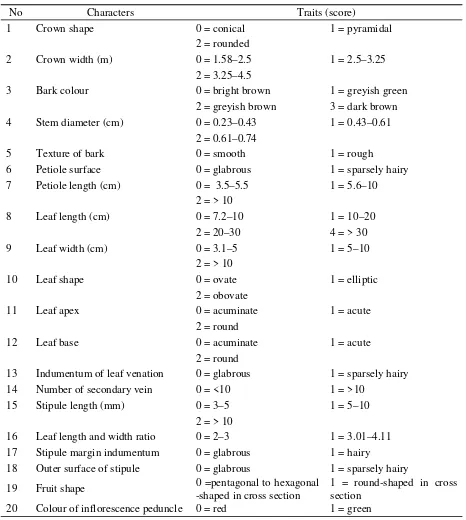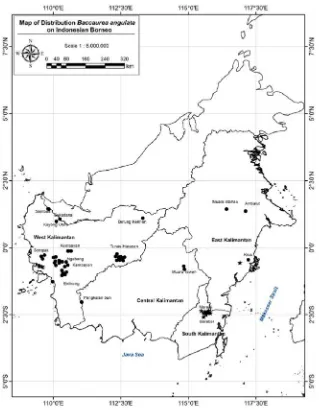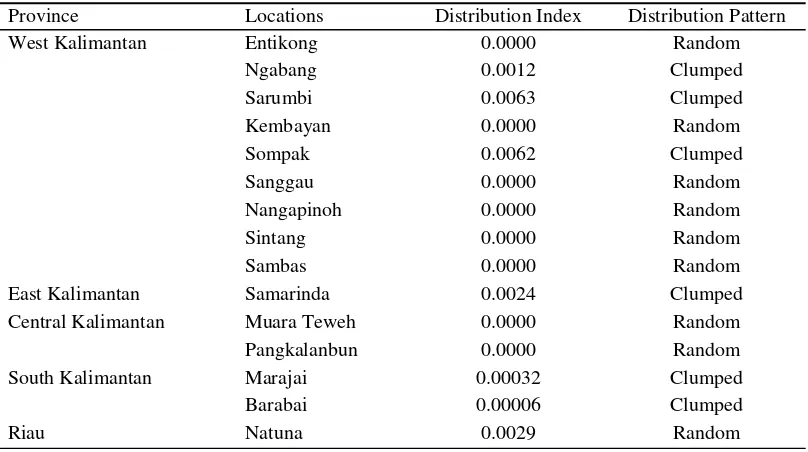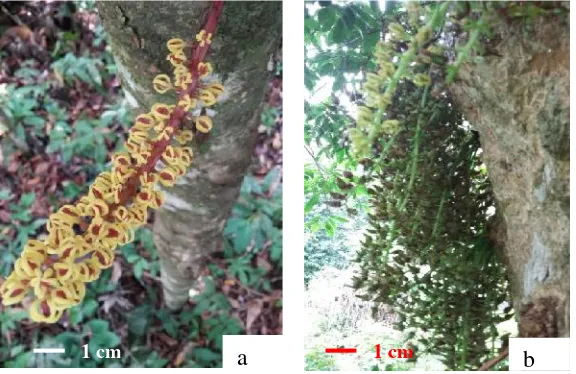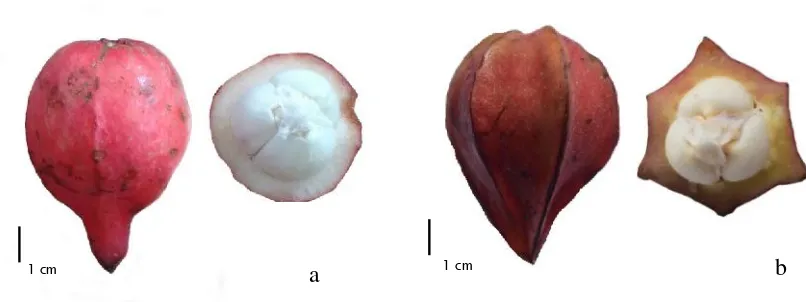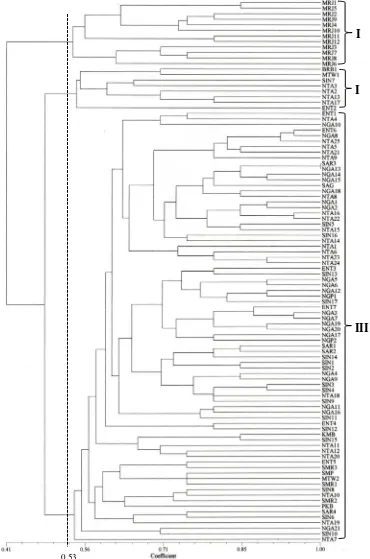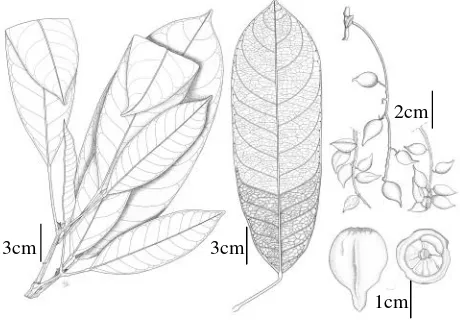DISTRIBUTION, MORPHOLOGICAL VARIATION
AND NEW VARIETY OF BACCAUREA ANGULATA MERR.(PHYLLANTHACEAE)
Gunawan1,2, Tatik Chikmawati3, Sobir4& Sulistijorini3
1
Plant Biology Graduate Program, Department of Biology, Faculty of Mathematic and Natural Sciences, Bogor Agricultural University, Bogor 16680 Indonesia
2
Department of Biology, Faculty of Mathematic and Natural Sciences, Lambung Mangkurat University, Banjarbaru 70714 Indonesia
3
Department of Biology, Faculty of Mathematic and Natural Sciences, Bogor Agricultural University, Bogor 16680 Indonesia
4Department of Agronomy and Horticulture, Faculty of Agriculture, Bogor Agricultural University,
Bogor 16680 Indonesia Email: [email protected]
Gunawan, Tatik Chikmawati, Sobir & Sulistijorini. 2018. Distribusi, Variasi Morfologi dan Varietas Baru dariBaccaurea angulataMerr. (Phyllanthaceae).Floribunda6(1): 1–11.—Baccaurea angulata(belimbing merah) adalah jenis endemik di Kalimantan yang dimanfaatkan sebagai bahan pangan dan obat tradisional, namun sejauh ini informasi distribusi dan variasinya masih sangat terbatas. Penelitian ini bertujuan me-metakan lokasi-lokasi tumbuh pohonB. angulata,menggambarkan variasi morfologi, dan analisis fenetikB. angulatayang tumbuh di Kalimantan dan Pulau Natuna. EksplorasiB. angulata dilakukan di Pulau Natuna dan empat provinsi di Kalimantan (Barat, Timur, Tengah dan Selatan). Peta persebaran dibuat dengan pro-gram ArcGIS versi 10.3. Pola distribusi dianalisis menggunakan indeks Morishita. Data morfologi batang, daun, bunga, dan buah digunakan untuk analisis fenetik belimbing merah berdasarkan koefisien Simple Matching(SM) dengan metode UPGMA.B. angulatatersebar secara acak di Kalimantan Barat, Tengah dan Pulau Natuna, tetapi memiliki pola penyebaran mengelompok di Kalimantan Selatan dan Timur. Penemuan B. angulatadi desa Ceruk dan Limau Manis di Pulau Natuna dengan nama lokal belimbing besi merupakan rekaman baru. Peta sebaranB. angulatadi Kalimantan dan Pulau Natuna disediakan. Secara morfologi,B. angulatadi Kalimantan dan Pulau Natuna bervariasi pada beberapa ciri yaitu tepi stipula, permukaan tangkai daun, warna tangkai perbungaan betina, dan bentuk buah. Analisis fenetik mengelompokkan seluruh sampel ke dalam tiga kelompok B. angulata berdasarkan 20 ciri morfologi dengan nilai keserupaan 53% sesuai dengan bentuk dan rasa buah. B. angulatadengan buah membulat diusulkan sebagai varietas baru dengan namaB. angulataMerr. var.globulusGunawan.
Kata kunci: Baccaurea angulata, Kalimantan, Pulau Natuna, rekaman baru, varietas baru, Phy-llanthaceae.
Gunawan, Tatik Chikmawati, Sobir & Sulistijorini. 2018. Distribution, Morphological Variation and New Variety of Baccaurea angulata Merr. (Phyllanthaceae). Floribunda 6(1): 1–11. — Baccaurea angulata (belimbing merah) is an endemic species of Borneo. Fruits of Baccaurea angulata are usually utilized as food and local medicine, but up to now the information about its distribution and variation is very scarce. The objectives of the research were to map the distribution, describe the morphological variation, and analyze the phenetics ofB. angulata inNatuna Island and Indonesian Borneo, Kalimantan.B. angulatawas explored in Natuna Island and four Provinces of Kalimantan (West, East, Central, and South). The dis-tribution was mapped using ArcGIS version 10.3. The disdis-tribution pattern was analyzed using the Morishita index. Morphological data of stem, leaves, flower and fruit were used to analyze the phenetics ofB. angulata using Simple Matching coefficient, to construct a dendrogram using UPGMA method. B. angulata is randomly distributed in the West and Central of Kalimantan, also in Natuna, but it has a clumped pattern in South and East Kalimantan. The presence ofB. angulatain the Ceruk and Limau Manis villages in Natuna Island with local name belimbing besi is a newrecord. B. angulata is morphologically variable in several characters, i.e. stipule margin, petiole surface, pistillate peduncle colour, and fruit shape. Phenetic analysis based on 20 characters grouped all individuals into three groups with similarity index of 53% according to the shape and fruit taste. The individuals of B. angulata with oval fruits are proposed to constitute a new variety, namelyB. angulataMerr. var.globulusGunawan.
Baccaurea angulata Merr. (belimbing merah; Phyllanthaceae) was first published by Merrill in 1929. This species has many different local names, for example: asam ketiak, pidau, umbing and umbung (Kalimantan, Borneo); emba-ling bobou, belimbing hutan (Brunei); embaemba-ling, belimbing uchong, pelawak, popotong, tampoi hutan, and liposu (Sabah); uchong, ujung, belim-bing bukit, belimbelim-bing dayak, belimbelim-bing hutan, belimbing merah, tampoi belimbing (Sarawak) (Haegens 2000; Lim 2012).
B. angulata is considered to have less economic value when compared to its relatives such as rambai (B. motleyana). Fortunately, it is a species used as a food source and it has the potential to develop into a medicinal plant in the future. This plant produces a red fruit with star fruit-like shape. The edible part of this fruit is its pericarp and aril with sweet to acidic flavour. B. angulatais found in primary and secondary forests between 0–800 m asl (Haegens 2000). The increasing conversion of forest into palm oil and rubber plantations negatively affects the B. angu-latapopulations by reducing its natural habitat.
Phytochemical analysis of the fruit peel of B. angulata has shown that it contains protein, carbohydrates, fibers, minerals and vitamin C (Voon & Kueh 1999), vitamin A, E and anthocyanin compounds (Ahmed et al. 2014; Norazlanshah et al. 2015). Mikail et al. (2014; 2015) reported that B. angulata juice can be used to prevent athero-sclerosis, inhibit lipid peroxidase activity and induce antioxidant enzyme activity.B. angulata also has the potency to be a source of natural ingredients for cancer treatment (Adam & Bahar 2015), an antioxidant (Ibrahim et al. 2013; Lim 2012), and to have anti microbial activity (Momandet al. 2014).
Previous studies (Haegens 2000; Uji 2004, 2007; Lim 2012) reported that the distribution of B. angulata is only in Borneo, where it is an endemic species. Up to now, no publication repor-ted the presence of B. angulata outside Borneo. The information on morphological variation within this species is also very limited. Then, the infor-mation on the existence of a plant in a place and its variations is useful for data collection of plant populations, recording the diversity of flora and its habitat, also its development for further uses (Les-tari 2014; Djuitaet al. 2016). This study aimed to provide distribution information, and analysis the
morphological variation withinB. angulata.
METHODS Exploration ofB. angulata
The exploration and sample collection ofB. angulata was carried out in Indonesian Borneo, Kalimantan and Natuna Island based on informa-tion from the forestry service and the local com-munities. The explored areas were 15 districts and cities in Kalimantan and Natuna Islands. The ex-plored areas in West Kalimantan included Enti-kong, Ngabang, Sarumbi, Kembayan, Sompak, Sa-nggau, Nangapinoh, Sintang and Sambas. In East Kalimantan, Samarinda was explored. In Central Kalimantan, Muara Teweh and Pangkalan were vi-sited. Marajai and Barabai were explored in South Kalimantan. In Natuna Islands Northeast Bunguran was sampled.
Distribution Mapping, Morphological Character Observation and Data Analysis
The distribution ofB. angulatawas mapped using ArcGIS version 10.3. based on the coordi-nates of the collecting point of the collections ma-de during the exploration with GPS 60 Garmin, label information in 14 specimens of Herbarium Bogoriense (BO), 5 specimens of Herbarium Wa-nariset (WAN), and 20 specimens images from Herbarium Leiden (L). The distribution pattern was analyzed using Morishita index (Ip) (Morishita 1959). The values and patterns of species distribu-tion are as follows: Ip = 0; random distribudistribu-tion, which individuals spread in several places and cluster elsewhere. Ip > 0; clumped distribution, where individuals always be in groups and so rarely to be separated. Ip < 0; uniform distribution, which individuals are located in a specific place within the community (Michael 1994).
Table 1. Characters and traits used in the phenetic analysis ofB. angulata
No Characters Traits (score)
1 Crown shape 0 = conical 1 = pyramidal
2 = rounded
2 Crown width (m) 0 = 1.58–2.5 1 = 2.5–3.25
2 = 3.25–4.5
3 Bark colour 0 = bright brown 1 = greyish green
2 = greyish brown 3 = dark brown
4 Stem diameter (cm) 0 = 0.23–0.43 1 = 0.43–0.61
2 = 0.61–0.74
5 Texture of bark 0 = smooth 1 = rough
6 Petiole surface 0 = glabrous 1 = sparsely hairy
7 Petiole length (cm) 0 = 3.5–5.5 1 = 5.6–10
2 = > 10
8 Leaf length (cm) 0 = 7.2–10 1 = 10–20
2 = 20–30 4 = > 30
9 Leaf width (cm) 0 = 3.1–5 1 = 5–10
2 = > 10
10 Leaf shape 0 = ovate 1 = elliptic
2 = obovate
11 Leaf apex 0 = acuminate 1 = acute
2 = round
12 Leaf base 0 = acuminate 1 = acute
2 = round
13 Indumentum of leaf venation 0 = glabrous 1 = sparsely hairy 14 Number of secondary vein 0 = <10 1 = >10
15 Stipule length (mm) 0 = 3–5 1 = 5–10
2 = > 10
16 Leaf length and width ratio 0 = 2–3 1 = 3.01–4.11 17 Stipule margin indumentum 0 = glabrous 1 = hairy
18 Outer surface of stipule 0 = glabrous 1 = sparsely hairy
19 Fruit shape 0 =pentagonal to hexagonal -shaped in cross section
1 = round-shaped in cross section
20 Colour of inflorescence peduncle 0 = red 1 = green
RESULTS AND DISCUSSION
Distribution of B. angulata in Indonesian Borneo and Natuna Island
Based on data collected from specimens at Herbarium Bogoriense, Herbarium Wanariset and as well as exploration sites, B. angulata is dis-tributed through out Kalimantan.B. angulata also distributed in Malaysia and Brunei (Haegens 2000). Some of the specimens collected before the
Figure 1. Distribution of B. angulata in Indonesian Borneo, Kalimantan. ●: obovoid and pentagonal to hexagonal-shaped fruits,⋆: obovoid and round-shaped fruits.
degradation can affect vegetation form and species distribution.
During the exploration of B. angulata, 98 trees were found. Sixty seven individuals were collected from primary and secondary forests, 5 individuals in a house yard, 23 individuals in the forest-edge and 3 individuals in the roadside. Local people utilize the fruit and harvest it directly from the forest and sell in the markets as fresh fruit. Based on the information from the local com-munity, until now there no effort has been made to propagateB. angulata, although they know that it has economic benefits. Previous studies have re-ported that the distribution of B. angulata is only in Borneo. However, based on our exploration, B.angulata is also found in Ceruk village and Limau Manis village, North East Bunguran Sub-district, Natuna Island, which is a new record.
Figure 2. Distribution ofB. angulatain Natuna Island.
Table 2. Distribution pattern ofB. angulatain Kalimantan and Natuna Island
Province Locations Distribution Index Distribution Pattern
West Kalimantan Entikong 0.0000 Random
Ngabang 0.0012 Clumped
Sarumbi 0.0063 Clumped
Kembayan 0.0000 Random
Sompak 0.0062 Clumped
Sanggau 0.0000 Random
Nangapinoh 0.0000 Random
Sintang 0.0000 Random
Sambas 0.0000 Random
East Kalimantan Samarinda 0.0024 Clumped
Central Kalimantan Muara Teweh 0.0000 Random
Pangkalanbun 0.0000 Random
South Kalimantan Marajai 0.00032 Clumped
Barabai 0.00006 Clumped
Riau Natuna 0.0029 Random
The local distribution of B. angulata shows variation distribution patterns (Table 2). Most specimens are spread randomly in West Kaliman-tan, East KalimanKaliman-tan, Central Kalimantan and in Natuna Island. However, in South Kalimantan a clumped pattern is found. This results is in agree-ment with Barbour et al. (1987) which stated that the pattern of distribution of seed plants tends to be clumped, because their seeds tend to fall near the
Morphological Variation ofB. angulata
B. angulata varied on some morphological characters such as the stipule margin, petiole surface, colour of the inflorescence peduncle, and the fruit shape. The stipule margin is ciliate or
glabrous (Figure 3). The petiole surface is glabrous or minutely hairy (Figure 4). The colour of the pistillate inflorescence peduncle is red or green (Figure 5). The fruit is either obovoid with a round shape or pentagonal to hexagonal (Figure 6).
a1
1 mm
b1
a2
b2
1 mm
Figure 3. Variation of the stipule margin, a1 & a2: ciliate margin, b1 & b2: glabrous margin. 1: photo, 2: drawing.
Figure 4. Variation of the petiole surface, a1 & a2: glabrous, b1 & b2: sparsely hairy. 1: photo, 2: drawing
a
1 cm 1 cm
b
a
b
1 cm 1 cm
Figure 6. Variation in fruit shape, a: obovoid and round-shaped cross section of fruit with an acuminate tip; b: obovoid and hexagonal-shaped cross section of fruit with an acute tip.
Fruit length is 3.5–6.7 cm, diameter 2.8–4.5 cm. Seeds are 1.56–1.9 cm long, and width 1.1– Haegens (2000). This shape is mainly concentrated in South Kalimantan (Fig. 1) in group I in the den-drogram (Fig. 7) and regarded here to constitute a new variety under the nameB. angulataMerr. var. globulus.
The fruits of B. angulata in Natuna Island have the same colour and star shape asB. angulata from Indonesian Borneo, but they are smaller. The characteristics of B. angulata in Natuna Island: Trees, is 8–11.5 m tall, 12–16.5 cm in diam, bark dark brown; densely hairy outside and ciliate along margin; petiole 3.5–6.5 cm long, glabrous; leaf blade oblong to ovoid, 12.3–26.5 by 4.4–6.5 cm, completely glabrous, upper surface shiny dark green lower surface pale green; inflorescenses 5– 13.6 cm long, green, 34–50 flowered, pedicels 1.45 –2 mm long, densely hairy; flowers 1.04–2.1 mm
The cluster analysis of 98 individuals was on 20 morphological characters. The resulting dendro-gram showed three major groups (Figure 7).
In similarity coefficient of 53%, all individu-als were divided into three major groups. Group I consists of 12 individuals collected in South Kali-mantan: Marajai (MRJ1, MRJ2, MRJ3, MRJ4, MRJ5, MRJ6, MRJ7, MRJ8, MRJ9, MRJ10,
MRJ11, MRJ12). Group I is grouped based on si-milarity of 7 characters: bark bright brown-colour-ed, crown slightly roundbrown-colour-ed, stipula with outside minutely-hairy, petiole minutely hairy, midrib mi-nutely hairy below, peduncle of pistillate inflores-cence red and fruit round-shaped in cross section. This group comprises the new variety.
Group II consists of eight individuals South Kalimantan: Barabai (BRB); West Kalimantan: Entikong (ENT2) and Sintang (SI7); Central Kali-mantan: Muara Teweh (MTW1), and Natuna Island (NTA2, NTA3, NTA13, NTA17). All indi-viduals in group II have similarity in 7 characters: of bark grayish-brown, crown conical, stipule gla-brous, petiole glagla-brous, midrib glagla-brous, peduncle of pistillate inflorescence green and fruit penta-gonal to hexapenta-gonal-shaped in cross section.
Group III consists of 77 individuals of B. angulata originating from West Kalimantan: Entikong (ENT1, ENT6, ENT3, ENT4, ENT5) Sarumbi (SAR1, SAR2, SAR3, SAR4), Ngabang (NGA1 to NGA21), Kembayan (KMB), Sintang (SIN1 through SIN17), Sanggau (SAG), Nangapi-noh (NGP1, NGP2); East Kalimantan: Samarinda (SMR1, SMR2, SMR3); Central Kalimantan: Pangkalan Bun (PKB), Muara Teweh (MTW2); Natuna (NTA1, NTA4, NTA8, NTA6, NTA7, NTA8, NTA9, NTA10, NTA11, NTA18, NTA19, NTA20, NTA21, NTA22, NTA23, NTA24, NTA25). Group III is characterized: bark dark brown, crown pyramidal, stipule hairy, petiole glabrous, midrib glabrous, peduncle of pistillate inflorescence green and fruit pentagonal to hexago-nal-shaped in cross section.
I
I
III
0.53
Figure 7. Dendrogram ofB. angulatagrouping based on 20 morphological characters using simple matching coefficient and UPGMA method. ENT. Entikong, NGA. Ngabang, SAR. Sarumbi, KMB. Kembayan, SMP. Sompak, SAG. Sanggau, NGP. Nangapinoh, SIN. Sintang, SBS. Sambas, SMR. Samarinda, MTW. Muara Teweh, PKB. Pangkalan Bun, MRJ. Marajai, BRB. Barabai, NTA. Natuna.
Barabai. Then, other specimens from West Kali-mantan (Entikong, Sarumbi, Ngabang, Kembayan, Kapuas Sintang, Sanggau, Nangapinoh, and Sama-rinda), East Kalimantan (SamaSama-rinda), and Central
Taxonomic Treatment B. angulataMerr.
B. angulataMerr., Univ. Calif. Publ. Bot. 15 (1929) 148; Meyer, Bot. News Bull. Forest Dept., Sabah 7 (1967) 35; Airy Shaw, Kew Bull, Addit. Ser. 4 (1975) 46; Haegens, Blumea (2000) 12. Type: Elmer 2/542 (holo A; iso B, DS, G, L, U), Borneo, Sabah, Tawau.
Tree 5.5–22 m high, 9.6–40 cm in diameter; branchlets glabrous; young shoots pale straw when fresh. Terminal branching pattern weakly develo-ped. Buttresses absent. Bark soft to hard, flaky, bright brown, grey-brown to red-brown to green, 9.6–40 cm in diameter; inner bark yellow to reddish to green, 0.6–4 mm thick. Stipules gla-brous to densely hairy outside, glagla-brous inside, margin ciliate, 4.2–11 mm. Leaves simple, alter-nate; blade elliptic to obovate, 12–40 cm, length/ width ratio 2.2–3.6:1; base cuneate to attenuate (rounded); margin entire; apex acuminate to cuspi-date to rarely obtuse; upper surface glabrous, dull to glossy dark green when fresh; lower surface glabrous, sometimes subglabrous at midrib; secon-dary veins 9–16 per side, closed at margin; vena-tion reticulate, not distinct; petiole 2–12.5 mm
long, cylindrical, glabrous. Staminate inflorescen-ces cauline, green, 0.5–26 cm long, flowers distri-buted along inflorescence up to 51 flower, sparsely hairy, 3 flowers per node. Staminate flowers ye-llow, 2–2.8 mm in diam., pedicel 2–4 mm long, sepals 4 or 5, obovate 1–1.5 mm long, apex slight-ly recurved, outside and inside denseslight-ly hairy; stamens 6, 0.5–0.7 mm long, glabrous; anthers 0.5 –0.6 by 0.1–0.3 mm, pistillode c.0.4 mm high, densely hairy, hollow. Pistillate inflorescences, green to red, solitary or up to 7 clustered together, 3.8–26 cm long, subglabrous to densely hairy. Pis-tillate flowers 4–9 mm in diam., sepals 5 or 6, elliptic, 8–9 mm long, outside and inside densely hairy; ovary urn-shaped, 3–5 mm long, 3-locular, densely hairy, wings 0–6; style absent; stigmas 0.6 –1.4 mm long, glabrous to subglabrous above, gla-brous to densely hairy below. Fruits obovoid, round to star-shaped in transverse section, 1–3-seeded, 3.5–6.7 cm fruit long, 2.8–4.5 cm in diam., base acute-acuminate, red to purple to pink to red-brown, petiole 4–8 mm long, pericarp 1–2 mm thick. Seeds globose to ellipsoid, laterally flatten-ed, 1.56–1.9 by 1.1–1.23 cm, testa bright brown. Arillode white, 2.1–4.23 mm thick; sweet to sweet-sour in flavour.
Identification key to the varieties
1. a. Leaf blades c. 2.2 times longer than wide. Pistillate inflorescence peduncle green to red. Fruit star-shaped in transverse section, apex acute... .... var.angulata b. Leaf blades 2.7–3.6 times longer than wide. Pistillate inflorescence peduncle red. Fruit round in
trans-verse section, apex acuminate... ....var.globulus
a.var.angulata
Bark grey-brown to red-brown to green when fresh; crown conical to pyramidal. Petiole glabrous; stipules glabrous to densely hairy out-side; leaf blades 12–39 by 4–13.6 cm, 2.2 times longer than wide; sometimes subglabrous at mi-drib. Peduncle of pistillate inflorescence green to red; fruits obovoid, star-shaped in cross section; apex acute.
Specimens examined. Indonesia, Borneo, West Kalimantan, Kayong Utara, 23 Maret 2010, Hery Yanto, Endri Setiawan, Adi Bejo, Edi 1906001 (BO); Indonesia, Borneo, West Kaliman-tan, Betung Karihun National Park, 23 Februari 2000, Sidiyasa K 1368339 (BO); Indonesia, Bor-neo, West Kalimantan, Ngabang, 23 Februari 2017,Gunawan012; Indonesia, Borneo, East Kali-mantan, Manubar, 16 Juli 1951, A. Kostermans 1476896 (BO); Indonesia, Borneo, East Kaliman-tan, Kayu Mahakam, 16 km from Ambalut, 18 July
1976, K. Kartawinata 1894543 (BO); Indonesia, Borneo, East Kalimantan, Kayu Mahakam, 16 km from Ambalut, 18 July 1976, K. Kartawinata 1894544 (BO); Indonesia, Borneo, East Kaliman-tan, Samarinda-Kurs, Kebun Raya Unmul, 11 Mei 2017, Gunawan 050; Indonesia, Borneo, Center Kalimantan, Muara Teweh, 20 Juni 2017, Guna-wan 063–064; Indonesia, Natuna, Limau Manis; 26 Mei 2017,Gunawan066–070; Indonesia, Natu-na, Ceruk 28 Mei 2017,Gunawan071–076.
Distribution: Borneo; Natuna
Habitat and Ecology: Primary and secondary rain forest, altitude 40–800 m asl
b. var.globulusGunawan, var. nov.–Fig. 8. – Type: Indonesia, Borneo, Kalimantan Timur, Tanah Merah, Lempake, 10 Km from Samarinda, 6 Januari 1977,K. Kartawinata1441 (BO).
minute-ly hairy, midrib minuteminute-ly hairy below, leaf blades 22.5–40 by 8.5–11 cm, 2.7–3.6 times longer than wide; peduncle of pistillate inflorescence red; fruit obovoid, round-shaped in transverse section; apex acuminate.
Ecology and habitat: primary forest, altitude 144–675 m asl.
Distribution: East and South Kalimantan. Local name: si lulung.
Utilization: fruit eaten, fruit peel also used as vegetables.
Specimens examined. Indonesia, Borneo, West Kalimantan, Tanah Merah, Lempake, 10 Km from Samarinda, 6 January 1977, K. Kartawinata 1441 (BO); Borneo, East Kalimantan, Kutai Ti-mur, Muara Wahau, PT. Narkata Rimba, 13 De-cember 2009, Arifin Z & Suharja I, 0926349 (WAN); Borneo, South Kalimantan, Balangan, Marajai, 6 June 2016,Gunawan082.
Local people commonly harvest fruits of B. angulata from the forest (Siregar 2005). In West Kalimantan, fruits of B. angulataare sold as fresh fruit or processed as a spice (sour-spicy spice) (Subektiet al. 2005). In Central Kalimantan, local people use the fruit as a fermented beverage. In South Kalimantan and Natuna Island, fruits of B. angulata are found in many traditional markets during the fruit season. In addition, the stem can be used as building materials and furniture (Lim 2012). In general,B. angulatablooms from July to September (Haegens 2000), and October to November will be in fruiting season. Based on observations, at the time of exploration and des-cription of the local poeple, the flowering season ofB. angulataalmost coincide with durian.
CONCLUSION
B. angulata was found to be distributed not only in Kalimantan but also in Natuna Island, with the local name belimbing besi, which has the same characteristics as B. angulata that grows in Kali-mantan. The morphological variations of B. angu-lata consisted of stipule margin, petiole surface, the color of pistillate inflorescence peduncle, and the shape of the fruit. Variants with round-shaped in transverse section and apex acuminate are pro-posed to be a new variety named B. angulatavar. globulus. It have been found only in East and South Kalimantan. Based on the morphological characteristics,B. angulatatrees were divided into 3 groups with similarity coefficient of 53%. Group I consisted ofB. angulata with rounded-shape and sweet flavor, group II is hexagonally-shaped fruit with sour flavor, and group III is group of B. angulatawith hexagonally-shaped fruit and sweet-sour flavor.
ACKNOWLEDGEMENTS
The authors would like to thank Ministry of Research, Technology, and Higher Education for providing BPPDN scholarship program which has funded this research. Head and staff of Herbarium Bogoriense (BO) and Wanariset Herbarium (WAN) are thank fully acknowledged for all the facilities provided.
REFERENCES
Adam M & Bahar MS. 2015. Expression of Ma-trix Metalloproteinase-13 in Human Skin Melanoma Cancer Treated by Baccaurea angulata in vitro. Journal of Basic and Applied Research1 (1): 21–28.
Ahmed IA, Mikail MA, Ibrahim M, Hazali N, Rasad MSBA, Gani RA, Wahab RA, Arief SJ & Yahya MNA. 2014. Antioxidant acto-vity and phenolic profile of various morpho-logical parts of underutilized Baccaurea angulata fruit. Food Chemistry.doi: http:// dx.doi.org/ 10.1016/j.foodchem.2014.09.122 Barbour MG, Burk JH & Pitts WD. 1987. Terrestrial Plant Ecology (2nd ed.). CA: The Benjamin/Cummings Publishing Com-pany, Inc.
Djuita NR, Hartana A, Chikmawati T & Dorly. Fig. 8.B. angulata Merr. var. globulus Gunawan,
var. nov. (K. Kartawinata 1441, Gunawan 082).
3cm 3cm
2016. Distribusi Kapulasan (Nephelium Ramboutan-Ake (Labill.) Leenh.) di Pulau Jawa dan Kekerabatan Morfologinya. Flori-bunda5(4):129–164
Haegens R. 2000. Taxonomy, phylogeny, and bio-geography ofBaccaurea, Distichirhops, and Nothobaccaurea (Euphorbiaceae). Blumea Supplement12.
Harris JG & Harris MW. 2006.Plant Identification Terminology. An Illustration Glossary. Utah (US): Spring Like Publishing.
Ibrahim D, Hazali N, Jauhari N, Omar MN, Yah-ya MNA, Ahmed IA, Mikail MA & Ibrahim M. 2013. Physicochemical and antioxidant characteristics of Baccaurea angulata fruit juice extract. African Journal of Biotech-nology12(34): 5333–5338.
Lestari R. 2014. Morphological Variation and Species Distribution of Baccaurea dulcis (Jack) Mull. Arg. in West Java, Indonesia. International Journal of Biology6(1):17–28 Lim TK. 2012.Edible Medicine and Non-Medicine
Plants: Volume 4. London New York. Spri-nger.
Merrill ED. 1929.Plantae Elmerianae Borneenses. Univ. Calf. Bot. 15: 145–153.
Mikail MA, Ahmed IA, Ibrahim M, Hazali N, Rasad MSBA, Ghani RA, Wahab RA, Arief SJ, Isa MLM, Draman S, Ishola AA & Yahya MNA. 2014. Changes in The Markers of Atherosclerosis Following Administration of Belimbing Dayak (Baccaurea angulata) Fruit Juice in Experimental Rabbits Fed With Cholesterol Diet. International Journal of Advances in Agricultural & Environ-mental Engg (IJAAEE) Vol. 1. http://dx.-doi.org/10. 15242/IJAAEE.C614516.
Mikail MA, Ahmed IA, Ibrahim M, Hazali N, Rasad MSBA, Ghani RA, Hashim R, Wahab RA, Arief SJ, Isa MLM, Draman S & Yahya MNA. 2015.Baccaurea angulatafruit inhi-bits lipid peroxidation and induces the in-crease in antioxidant enzyme activities. Eu-ropean Journal Nutrition. DOI 10.1007/ s00394-015-0961-7.
Michael PE.1994.Metode Ekologi untuk Penye-lidikan Ladang dan Laboratorium. Univer-sitas Indonesia. Jakarta.
Momand L, Zakaria R, Ibrahim M, Mikail M, Jalal T & Wahab A. 2014. Antimicrobial effect of
Baccaurea angulata fruits extracts against human pathogenic microorganisms. Medical & Aromatic Plants V. 3(4):1–5. http:// dx.doi. org/10.4172/2167-0412.1000172. Morishita M. 1959. Measuring of The Dispersion
on Individuals and Analysis of the Distribu-tional Patterns. Kyushu University. Japan Norazlanshah, Afiq M, Muhammad & Masri M.
2015. Determination of phytochemicals and vitamin content of under utilized Baccaurea angulata fruit.Journal Pharmacognosy and Phytochemsitry4(4): 192–196.
Ouinsavi C & Sokpon N. 2010. Morphological variation and ecological structure of Iroko (Milicia excelsaWelw CC Berg) population accross different biogeographical zones in Benin.International Journal of Forestry Re-search, 1, 1–11. http://dx.doi.org/10. 1155/ 2010/658396.
Rifai MA & Puryadi D. 2008. Glosarium Biologi. Jakarta (ID). Pusat Bahasa Departemen Pen-didikan Nasional.
Rohlf FJ. 2004. NTSyspc. Numerical Taxonomy and Multivariate Analysis System. User Guide. Department of Ecology and Evolu-kung Domestikasi dan Komersialisasi Jenis, Spesies, dan Varietas Tanaman Buah di Ka-limantan Barat. Prosiding Lokakarya I Do-mestikasi & Komersialisasi Tanaman Horti-kultura. Puslitbang Hortikultura, Balitbang Pertanian, Departemen Pertanian. Jakarta. 23 –34.
Uji T. 2004. Keanekaragaman Jenis, Plasma Nut-fah, dan Potensi Buah-buahan Asli Kaliman-tan.BioSmart6(2): 117–125.
Uji T. 2007. Review: Keanekaragaman Jenis Buah-Buahan Asli Indonesia dan Potensinya. Bio-diversitas8(2): 157–167.
